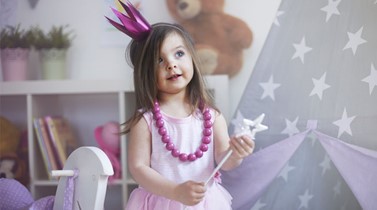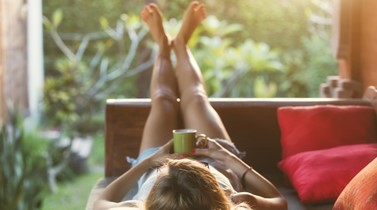Disney princesses & their effect on our daughters

Who is the fairest of them all?
Many little girls dream of being a princess, but Sarah Tennant asks if the Disney marketing machine is setting our daughters up for a life lived not so happily ever after.
Quick, name a princess. If you answer "Anne" or "Alexandra", congratulations - you know more about the monarchy than most Kiwis (including me, actually, I had to look it up). But if you have a daughter under the age of seven, I'm willing to bet your first thought was along the lines of "Belle" or "Ariel". What's more, there's a good chance you're sitting less than 10 metres away from a product bearing said princess's smile. And that applies whether or not you're anti-plastic, anti-consumerist, anti-sweatshops, anti-fairytales or just plain anti-princess.
They're everywhere - Hollywood's 10 Most Influential Fictional Businesswomen - the Disney princesses. Scratch that, Disney Princesses, capitalised. The capitalisation is important, because in fact, a Princess isn't necessarily a princess. Non-royals Mulan and Pocahontas make the cut, while Nala (Simba's queen) and Megara (wife of sort-of-prince demi-god Hercules) don't. Even Tinkerbell was briefly considered for the line-up, eventually getting her own spin-off franchise instead. Actual royal qualifications don't matter, marketability does.
The phenomenon began in 2000, when Disney realised mothers were making their little girls Cinderella dresses instead of buying officially licensed ones. At least 26,000 products later, girls can not only buy a Cinderella dress untainted by a mother's loving stitches, they can buy a Cinderella bedspread, Cinderella bubble bath, a Cinderella-as-a-toddler doll with a Royal Styling Throne, and a Cinderella toaster (it chars the outline of a glass slipper onto the bread). Disney Princesses have earned the company US$4 billion worldwide.
The latest two princesses, Tiana (loosely based on The Frog Princess book) and Rapunzel, were inaugurated into the official line-up with lavish coronation ceremonies. And in 2012 the US marked the first annual National Princess Week (April 22-28, double-booked with National Infertility Awareness Week, but hey, sparkles!).
The princesses' moral code
Not surprisingly, the ubiquity of the princesses has made them a hot topic among parents. "The New Mommy Wars?", blared a headline in the Christian Science Monitor. And indeed, a quick browse on the internet shows that we mothers are perhaps even more princess-obsessed than our daughters. Disney's royals have had every aspect analysed, criticised and defended, from their effect on our daughters' body image and self esteem to their morals and messages and cultural importance. You name it, somebody's blogged about it.
Or in Peggy Orenstein's case, written a book about it. Cinderella Ate My Daughter is a witty, wry look at the princess phenomenon from a feminist mother who was horrified to find her preschooler Daisy slavering after all things pink and frilly. Orenstein isn't entirely anti-princess - she has a soft spot for Mulan - but she takes issue with what she sees as sexism and racism in the films, as well as the relentless marketing.
Orenstein isn't alone in considering the princesses poor role models. One endlessly-Facebooked image shows the smiling princesses en masse, captioned with the "morals" of their stories.
Under Snow White: "At first it may seem terrible, being so beautiful that other women get jealous enough to try and kill you. But don't worry, once your beauty attracts a man, he'll protect you."
Ariel's message: "It's okay to abandon your family, drastically change your body and give up your strongest talent for a man. Once he sees your pretty face, only a witch's spell could draw his eyes away from you."
But for every damning critique, you'll find someone else espousing the virtues of the Disney princesses. For instance, one blogger claims Belle suffers from Stockholm Syndrome and teaches girls to stay with abusive boyfriends.
No, says another, she shows that character is more important than appearances and she reads Shakespeare to boot.
Is Jasmine a fetishised Orientalist fantasy who lets her boyfriend off the hook for lying about who he is? Or is she an empowered woman who refuses to submit to the patriarchy and takes charge of her own sexuality to trick the villain?
And depending who you ask, Snow White's offer to keep house for the seven dwarves in exchange for board is either plucky and resourceful, or hopelessly subjugated. One blog commentator even defended The Little Mermaid on the grounds that it was an ahead-of-its-time trans-gender allegory. Ariel just wanted her inside to match her outside, you see.
But one has to wonder how much of this subtext our daughters are mentally capable of internalising. Even if you grant that Cinderella should have left her abusive step-family rather than waiting on them, will watching the movie really make our little girls more likely to end up domestically enslaved?
Maternally Monstrous blogger "Anne" wrote that, while she sees problems with Disney's portrayal of gender now, as a child she found the stories empowering.
"Disney princesses let my young self believe that reading was cool (Belle), taught me some of the first songs I ever had the courage to sing out loud (Ariel), provided an example of the value of fairness and friendship (Snow White) and, in the gender-bending form of Mulan, made the bold statement that tradition was often bunk and it was our duty as able-bodied girls to set things straight."
The princess effect 101
Unfortunately, when it comes to the effects of princess exposure on developing psyches, we don't have much solid data to go on. The post-princess era girls, those who were in the three-to-six-year-old target demographic in 2000, when the heavy marketing started, are barely grown up. And they've been exposed to countless other messages about women, body image, consumerism and so on along the way. Was Disney really any more responsible for shaping their world views than Lindsay Lohan, Britney Spears, Hannah Montana, Kim Possible or, dare I say it, their own parents and peers? I wouldn't like to be the researcher responsible for teasing apart those variables.
There have been attempts, of course. A 2009 study had young girls watching Disney clips that specifically mentioned appearance, such as Gaston about Belle: "The most beautiful girl in town, and that makes her the best!"; other girls watched clips of "neutral" shows, such as Dora the Explorer (old Dora, one assumes, not the new princess version). Afterwards, the girls were interviewed and observed at play.
The researchers found that the princess-watching girls were no more likely to play appearance-related games, such as dress-ups, nor more likely to associate thinness with being a princess or to worry about their weight.
Of course, I'm more concerned about Disney's effect on my own daughter than anyone else's. Rowan is four, and despite growing up with no TV, no daycare or kindergarten and an anti-consumerist (read: broke) family vibe, she's pretty darn princess-savvy. Her Snow White dress, home-made, if you please, is nearly worn to shreds. She sings "Part of Your World" on repeat as long as any car trip lasts; and thanks to Tiana, she wants to be a waitress when she grows up. (Yep, not a princess, a cook or restaurateur, a waitress. It's possible she missed some of the nuances of The Princess and the Frog film.)
My attitude to Rowan's princess love fluctuates. At times I see her scrambling out of her Snow White dress so she can climb a tree naked, and think, "She'll be fine." At other times I find myself cross-examining her like a guilt-ridden sociologist.
"What do princesses do?" I asked her casually, quaking inside that she'd indict my parenting with a reply like, "get married" or "wear pretty dresses". Rowan didn't skip a beat. "They dance."
Well, okay, I can live with that.
Marketing machine
As I see it, the problem with the princesses isn't so much the movies. It's the marketing. After all, there are only 10 princess movies - 20ish if you count the sequels - but there are 26,000 tie-in products and counting. And Disney is very good at drowning out the genuinely good messages of its films with a tsunami of merchandise.Take Tiana, for instance. Tiana is a no-nonsense, hard-working go-getter with an acid tongue... in the movie. On lunchboxes and duvet covers, however, she's bland and decorative. Tiana wears her most "magical" dress - the one visible for perhaps 10 seconds of screen time - rather than her waitressing outfit.
Equally Mulan is rarely pictured in her warrior gear. Her dress is gradually becoming less Chinese and more "princess".
Even Pocahontas' Native American costume now comes with a few sparkles. Eagle-eyed collectors have noticed that the new doll's skin is lighter than her predecessor's.
Perhaps the most blatant victim of personality-scrapping is Merida. The fiery heroine of Brave, Merida isn't yet an official Disney princess - her unique status as a Disney-owned Pixar creation may be complicating her eligibility. But princess or not, Disney is enthusiastically pushing Merida merchandise... merchandise which manages to entirely miss the point of her character. Watching Brave, it's hard to miss the fact that Merida hates fancy clothing and primping. But on the shelves, the Gem Styling Merida Doll is itching for some bling.
In other words, our girls aren't even being sold Cinderella and Belle. They're being sold de-personalised, tweaked, homogenised versions of Cinderella and Belle - demure and dainty clothes horses, not characters.
Then there's the fact that so many princess products revolve around beauty. Yet none of Disney's leading ladies on screen have been vain. Their attitude towards their own beauty ranges from serene unconsciousness to mild annoyance. Rapunzel's hair gets in the way and Belle's good looks attract the attention of the leering Gaston. Looking at the vast array of lotions, hairbrushes, mirrors and shimmer body lotion featuring the princesses, you'd think they spent whole movies primping.
And they all lived…
Of course, my solution to the princess issue isn't as simple as "yes to movies, no to merchandise". What I've gained from the debate is a new appreciation of variety. Princesses are like crack to preschoolers, and Rowan would happily watch/sing/wear only Disney movies/songs/clothing for the foreseeable future. But, as Orenstein puts it, pink is a small slice of the rainbow. If a girl's idea of individuality is choosing between a Tiana and a Jasmine backpack, she's missing out on a lot.
Some parents try to balance and critique "happily ever after" princesses with less traditional ones, such as the feisty heroines of The Paper Bag Princess, Princess Smartypants and Princess Pigsty, Some of this so-called "anti-princess literature" is witty and fun; some of it, not so much.
Personally, I'm ho-hum on the idea of simply expanding the definition of princess ("princesses can be microbiologists too!"). I'd rather flood my daughter's imagination with so many awesome non-princess characters that she won't consider tiaras and marriage essential to a good story.
Cinderella and Aurora aren't likely to turn Rowan into a prince-pining flower if they're in competition with Tabitha Twitchit, Harriet the Spy, Mrs Pepperpot, Mary Poppins, Pippi Longstocking and all the other female characters who've enthralled girls for decades.
Okay, so technically Pippi's a princess because she's the daughter of, um, a cannibal king. I wonder what the blogosphere has to say about that one?
Sarah Tennant lives at the back of an apple orchard with her husband, daughter Rowan, aged four, and son Miles, one. Like everyone else, she thinks the Beast looked better before he was transformed into a prince.

AS FEATURED IN ISSUE 20 OF OHbaby! MAGAZINE. CHECK OUT OTHER ARTICLES IN THIS ISSUE BELOW

















